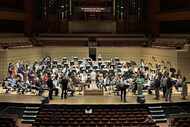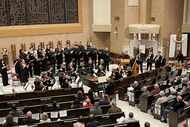With a lot of young people in attendance, the audience for Thursday night’s Dallas Symphony Orchestra concert was certainly enthusiastic. But guest conductor Simone Young’s big and rather generalized gestures didn’t get the most disciplined playing from the orchestra.
The program had a second-half showpiece in Richard Strauss’ Nietzsche-inspired tone poem Also sprach Zarathustra, and a very serious first half of Estonian composer Arvo Pärt’s Cantus in Memoriam Benjamin Britten and the Britten Violin Concerto.
Star of the evening was co-concertmaster Nathan Olson, the brilliant soloist in the Britten concerto. Composed in 1938-39, with the Spanish Civil War still raging and World War II underway, it’s both a protest and a memorial from the pacifist composer. Spanish rhythms and melodies allude to the former conflict, and are a nod to the Spanish violinist Antonio Brosa, who gave the 1940 premiere. Britten revised the concerto three times in the 1950s.
Hushed cymbals and timpani introduce the work, the latter’s rhythmic figure a recurrent motif. After an exploratory entrance, the solo violin sets off on a sassy dance, interrupted by alarms sounded by brass and drums. It’s too bad loud applause broke out after the movement’s quietly unsettled ending.
The middle movement is a diabolical scherzo, a danse macabre with more than a hint of Prokofiev. It’s also a virtuoso showpiece, punctuated by assaults of brass and percussion and a quirky dialogue between piccolos and tuba.
A stream-of-consciousness solo cadenza explores possibilities before trombones introduce the finale’s passacaglia, a set of variations on a rising-and-falling theme. Once again, trumpets make their martial inclinations known, but the movement ends in a great decrescendo into silence — this time properly broken only when Young put down her baton.
That third movement outlasts my attention span, but Olson’s performance of the concerto was by turns virtuosic, atmospheric and properly unsettling. Technical challenges were dispatched with utter authority — and musicality. Here and there one could imagine a tauter orchestral collaboration, but it made a good case for the piece.
The Pärt, introduced by quietly funeral bell tollings, explores washes and swirling eddies of strings. A long crescendo leads to a long sustained chord, its release leaving the bell faintly ringing. Even here one could imagine a finer focus to the performance.
The opening of the Strauss, with solemn trumpet fanfares answered by timpani, was popularized by the 1968 film 2001: A Space Odyssey. The DSO performance stirred up thrilling sounds, and it was refreshing to have a conductor not determined to muffle an organ part. Bradley Hunter Welch made generous use of seismic pedal registers of the Meyerson Symphony Center’s big C.B. Fisk organ.
But Young’s great sweeping gestures, whether the music was loud or soft, didn’t foster focus and precision. Violins weren’t always tidy, and the winds’ final chords were hazily tuned. But there were fine solos from associate concertmaster Emmanuelle Boisvert and principal cellist Christopher Adkins.
Details
Repeats at 7:30 p.m. Friday and Saturday, 3 p.m. Sunday at Meyerson Symphony Center, 2301 Flora St. $44 to $259. 214-849-4376, dallassymphony.org.





/cloudfront-us-east-1.images.arcpublishing.com/dmn/ITESS7AAC5VIKBEYJL4HZZPHYA.jpg)
/cloudfront-us-east-1.images.arcpublishing.com/dmn/FEXRJG5H5VCKDLI4Q7ZDC2OJ3Q.jpg)
:no_upscale()/cloudfront-us-east-1.images.arcpublishing.com/dmn/FGMATCSGLKPS7ZC4U7A4QS4IHM.jpg)
:no_upscale()/cloudfront-us-east-1.images.arcpublishing.com/dmn/VV3O77J4DBH5RPTY2DSA3U4GGU.jpg)
/cloudfront-us-east-1.images.arcpublishing.com/dmn/VVGIMAHWGFF2BPST7A36S4AYJY.jpg)